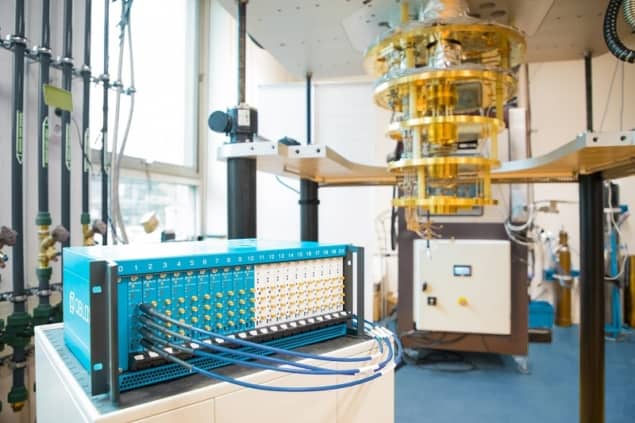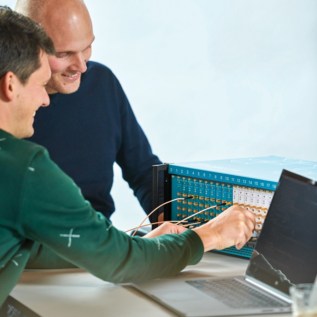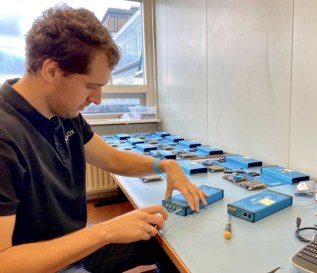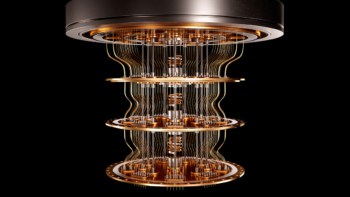Dutch start-up Qblox has created a single modular unit providing all the input and output signals from ultrastable DC to 18.5 GHz needed to replace the myriad of discrete instruments that are typically used to control a quantum computer

A quantum chip may measure just a few millimetres across, but the equipment needed to cool, control and measure such delicate quantum systems can fill an entire physics lab. Quite apart from the large cryostat that maintains the qubits at ultracold temperatures, a typical experimental set-up incorporates dozens of discrete electronic instruments that enable the quantum processor to perform logic operations.
Since a quantum processor is essentially an analogue system, electronics equipment is needed to convert digital commands from a conventional computer into high-frequency electric pulses that alter the state of the qubit. Data acquisition systems are then used to measure the result of the quantum operation and relay it back to the PC.

“Most quantum labs patch together a solution using separate pieces of general-purpose lab equipment,” says Niels Bultink, an experimental quantum physicist and co-founder of start-up company Qblox. “These instruments have not been optimized for the specific needs of quantum systems, and it takes a lot of time and money to set up the experiments.”
Such complex experimental set-ups not only occupy a lot of lab space, but they are also prone to errors and connectivity issues that can be difficult to locate and resolve. The hardware challenge is difficult enough when controlling quantum processors containing just a few qubits, but such piecemeal installations for quantum control and measurement will become unsustainable as researchers scale up their quantum processors – from tens of qubits today to hundreds and even thousands of quantum bits in the future.
That hardware bottleneck has been apparent for some time, and in 2015 Bultink was a PhD researcher working on an IARPA-funded project with professor Leonardo DiCarlo at QuTech – a quantum research centre in Delft, the Netherlands – to develop more scalable control electronics. Bultink saw commercial potential in the instrumentation he was working on, and in 2018 he joined forces with fellow physicist Jules van Oven to establish Qblox and bring fully-integrated control electronics to the growing quantum market.
Using the technology developed QuTech as a springboard, the Qblox team has fundamentally reimagined the architecture of quantum control to create a single integrated system, called the Cluster, that provides all the functionality needed to manipulate and measure quantum computers.
“With general-purpose lab equipment it can take weeks or even months to fine tune all the parameters for a multi-qubit device,” comments Butlink. “The Qblox architecture can speed up these routines by orders of magnitude, saving research teams significant amounts of time and money.”
The Cluster is a modular system that has been designed with scalability in mind: a single unit fits inside a standard 19″ rack mount and provides control of systems containing a maximum of 20 qubits, while additional modules can be connected together to operate quantum processors with hundreds of quantum bits.
We have created an entirely new architecture tailored to the peculiar requirements of qubits, reducing size by factor of 100.
Neil Bultink, Qblox co-founder
Each module in the Cluster system contains all the instrumentation needed to control and read-out a quantum computer, including waveform generators, frequency up- and down-conversion and data-acquisition tools. As well as miniaturizing the electronic components and integrating them together, each of the components has been optimized for use with quantum systems. “We have created an entirely new architecture tailored to the peculiar requirements of qubits, reducing size by factor of 100,” says Butlink.
One key focus for the Qblox team was to minimize the noise in the instrumentation, since quantum systems are extremely sensitive to noise. “The noise from the control system directly induces errors in quantum computation,” explains Bultink. “We developed a new class of waveform generator that operates at noise levels four times lower than the best alternative on the market.”
Careful attention was also taken to reduce drift in the instrumentation, which is essential to ensure that measurements are stable and reproducible. Gain and offset drifts have been reduced by a factor 10 towards just a few ppm/K, while automated calibration reduces time needed to set up the equipment from weeks to just a few hours.
Along with developing the hardware, Qblox has created an open-source control software called Quantify (with co-development partner, Orange Quantum Systems). “Quantify contains all the basic functionality to control experiments,” explains Bultink. “It also has a novel scheduler featuring a unique hybrid control model that allows quantum gate- and pulse-level descriptions to be combined in a clearly defined and hardware-agnostic way.”

As well as optimizing the performance of the electronics in each individual module, one of the big challenges for the Qblox team was to ensure that multiple modules connected together would work effectively as a single, larger unit. This needs precise timing control to ensure that the control and read-out tasks performed by each module are synchronized together, and to achieve this Qblox has exploited their proprietary SYNQ protocol to ensure that all outgoing signals have a fixed and stable timing relation with respect to each other down to the nanosecond.
The other important parameter is latency, a measure of the time taken for the control system to send signals to the quantum system and record the result. Low latency is essential for experimental protocols that require feedback mechanisms, such as quantum error correction (QEC), where the control of one qubit depends on the measurement of another qubit just a few hundreds of nanoseconds earlier. “QEC is an emerging research area that seeks to remove errors from a quantum system,” explains Butlink. “Qubits are faulty by nature, and the ability to correct for these errors becomes increasingly important as more qubits are added to the system.”
Butlink explains that QEC requires the time between a measurement and a subsequent operation to be short compared to the timescale at which qubits can contain their information, which becomes more challenging as the control system is scaled up.
“For this, we have created a massively scalable infrastructure to share qubit measurement outcomes between the modules,” continues Bultink. The LINQ protocol developed by Qblox distributes measurement outcomes to all modules in less than 200 ns. “Doing this for a handful of qubits may sound difficult, but solving this for hundreds of qubits is one of the coolest challenges we have ever worked on,” he says.
The Cluster system can be used to control just about any experimental implementation of a quantum processor. Existing customers are using the system to control quantum computers based on superconducting qubits and quantum dots, for which the Cluster provides a single plug-and-play solution that can directly generate signals ranging from ultrastable DC to frequencies up to 18.5 GHz. For some quantum systems, such as those based on trapped ions, cold atoms, or nitrogen-vacancy (NV) centres in diamond, additional laser systems are needed for conversion into the optical regime, although all the necessary interfaces are provided.
We want researchers to challenge us with their experimental requirements. Our goal is to solve their control stack problems.
Neil Bultink, Qblox co-founder
Indeed, the Qblox team is currently installing a Cluster system for use with a quantum processor based on diamond NV centres. “We want researchers to challenge us with their experimental requirements,” says Bultink. “Our goal is to solve their control stack problems.”
While the Cluster systems can handle set-ups with hundreds of qubits, Bultink is well aware that quantum computers are likely to need thousands of qubits to offer a realistic alternative to classic computation. It may be early days to reveal the next milestone on the Qblox roadmap, but the company is part of an EU-funded project (part of Horizon 2020) that aims to produce the hardware needed to control systems with more than a thousand qubits.
More generally, Bultink sees Qblox as a vital part of a growing commercial ecosystem for the development of practical quantum computers with real-world applications. “It is really exciting to be part of the birth of the quantum industry,” he says. “More companies are providing solutions for different elements of a quantum computing build – not necessarily competing, but producing systems that can be integrated together to enable the first applications of quantum computing.”




